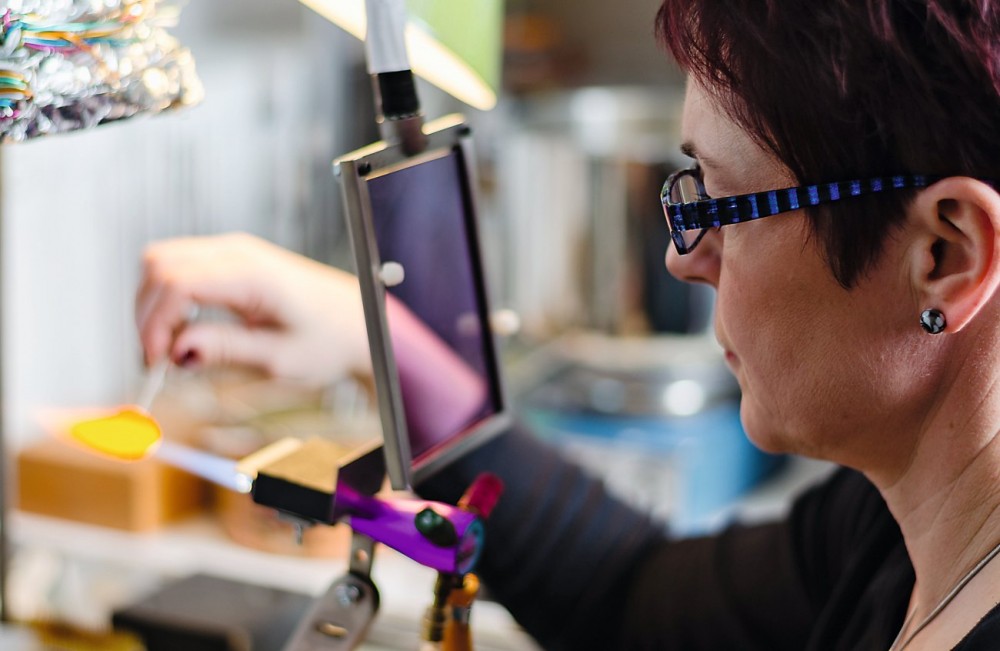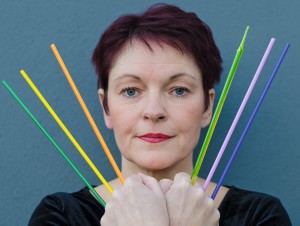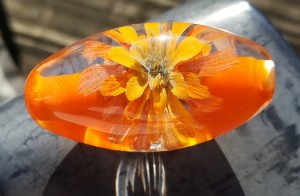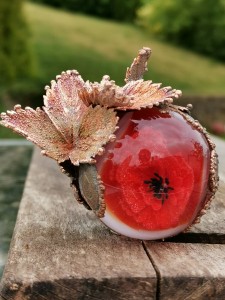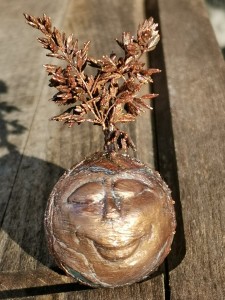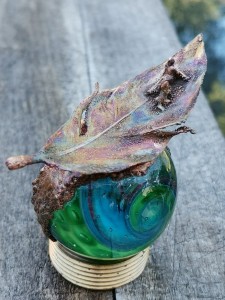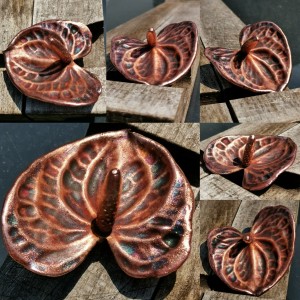Petra Pepper from Mülheim creates art objects from glass and enhances them with electroplated stylistic elements.
I've always enjoyed working and trying my hand at creativity," Petra Pepper begins when asked about her motivation for electroplating art objects. "At first, I concentrated on painting - with two painting courses and early works in acrylic."
That was nine years ago and in the meantime Petra Pepper's art has become three-dimensional, as she discovered glass as a material in 2014: "I was so fascinated by the fact that you can melt glass on a table-top burner that I immediately signed up for a basic course and set up a small workstation at home straight away." She attributes her curiosity and love of experimentation to her job as a laboratory technician, even calling these two characteristics "an occupational disease".
This occupational disease - with the support of the World Wide Web as a source of inspiration - ultimately led to Pepper taking her first steps with electroplated glass. 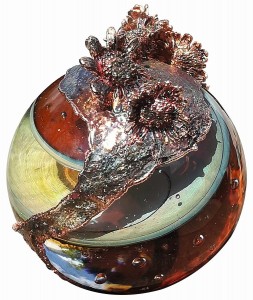
"Chance brought me a used electroplating machine, so I couldn't help but combine glass art with electroplating art." Pepper realized that it wasn't that simple after the first few attempts. The saleswoman at the rectifier had lent her a 30-year-old Hobbythek book, which she used to get started, but after three attempts, all of which involved pendants, it was time to call it a day. Although the result was quite successful.
Nevertheless, the seed was sown and after intensive literature and internet research, she continued. Pepper bought a better rectifier and a large pot of copper conductive paint from a garage. In general: "Getting chemicals over the internet is no problem and there were a few copper scraps for me at a local metal shop." Pepper's ambition was awakened.
Petra Pepper realized that ambition alone was not enough as soon as the first results were available. "I had massive problems with the layer adhesion and it was often unsightly. Today I know that I probably made all the mistakes you can make back then." So it was back to researching and learning. The artist again found tips and inspiration on the internet, particularly in the Facebook forum Galvanotechnik. Today, she roughens the glass surface with a hand grinder, scores the workpiece and finally degreases it with spirit. Then she uses her secret tip, Jason's Dipp, a graphite conductive lacquer that she mixes herself using a recipe from Jason Welsh. Pepper currently only copperplates her glass pieces using an acidic copper electrolyte. Sometimes without any additives, sometimes with additives according to (again) Jason Welsh. The post-treatment then consists of grinding and polishing, sometimes also patinating. The new results are undoubtedly impressive, but she still sees herself in the phase of finding what is best for her.
Galvano start with used equipment
Of course, the use of higher-quality materials, such as gold or silver, is also possible in art. However, Petra Pepper does not want to electroplate precious metal layers herself: "My actual medium is glass. If there are ever pieces that deserve an upgrade from copper to a precious metal, I would outsource it. But it's true that there are an awful lot of design techniques, there's potential for more than one lifetime!"
In this context, she also mentions anodization, which could also be used in jewelry design, for example with aluminium or even titanium. Although Pepper sees this as "an interesting topic", she also knows that it will be technically more challenging. She is quite realistic about her space and time limits. Nevertheless, the artist has already gold- and silver-plated pieces. But not galvanically, but by burning on. 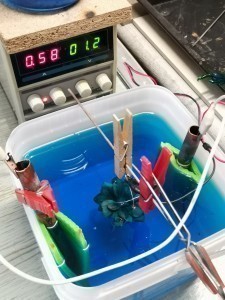 Electroplating on a small scale. Acid copper plating is used here.
Electroplating on a small scale. Acid copper plating is used here.
The method of fire plating (i.e. with a mercury amalgam), which has been known for thousands of years, is out of the question. Instead, in the artistic field, a metal leaf (e.g. gold leaf) is applied to the hot workpiece. The workpiece must be at the right temperature. If it is too hot, the applied metal will burn off immediately. Silver wire is also sometimes placed around a bead as a design element. When heated, the wire forms small beads, which creates a beautiful effect.
In terms of electroplating, she is still in the discovery phase, but she is not critical of this. Because: "A technically unsuccessful electroplating coating can be artistically valuable."
Plants are also coated
In addition to Petra Pepper's favorite medium, glass, she also coats plants and plant parts. While adhesion is the biggest problem with glass, the filigree structures are the main problem when coating plants. Until now, the artist has only coated fresh plants, i.e. they have not been dried before processing. They are coated or dipped in a thin layer of varnish. While orchids and leaves are usually thick enough to hold their shape, this is more difficult with delicate flowers. The flower often collapses. Pepper is still in the experimental phase here too. One option she sees is to varnish the flowers twice. First with a clear varnish, then later with the conductive varnish.
A well-known photographer's saying is that a motif is not created in the camera but in the photographer's head. How does Pepper find inspiration for her work? "The flood of images on the internet often overloads me. But I still get inspiration from there. I usually have a rough idea in my head - and then everything turns out differently. In any case, melting glass is a spontaneous process, you have to follow the glass, there's no correcting it later.
However, changes or improvements can be made later through cold processing, which includes electroplating. This is where Pepper follows spontaneous ideas and gives free rein to her creativity. She calls this a "dynamic process": starting with an idea and seeing where it leads.
Artists also have to deal with the more menial aspects of everyday life and in this context the question arises as to how the used chemicals from the creative processes are later disposed of. It is clear that Petra Pepper hands in her chemicals at the municipal hazardous waste collection point for professional treatment.
The artist would never have believed that she would one day become such a skilled artist that she would be able to pass on her knowledge and skills to others. All the more reason for her to enjoy giving individual courses for advanced beadmakers. Overall, Petra Pepper is pleased that in times of increasing standardization in society, individuality is once again gaining ground. Homemade items such as clothing, furniture, jewelry, even poetry or creative writing are popular with people. She encourages people to find inspiration online: "YouTube, Facebook and Pinterest are full of ideas. The instructions for doing it yourself are often included and people see how easy some things can be that they would never have dared to do before. You then often only need to follow the instructions exactly.
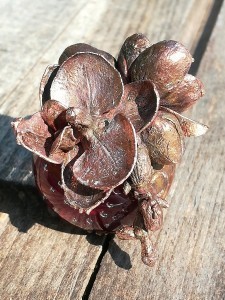 A finished work. However, if precious metals are used, she will most likely have them applied externally.what does the future hold for Petra Pepper herself? What does she want to create? Are there any big projects on the horizon?
A finished work. However, if precious metals are used, she will most likely have them applied externally.what does the future hold for Petra Pepper herself? What does she want to create? Are there any big projects on the horizon?
She doesn't give it much thought herself. "I'm not planning anything in that direction. After all, the development of the last five years wasn't planned either." There is only one thing she is determined not to lose: her fascination and her willingness to experiment, which she calls her driving force. But there is little danger of that. One thing is certain: "As long as I can maintain my playfulness and curiosity, my art will develop. We'll see where."
Petra Pepper's workshop mainly produces glass art, which she coats on a case-by-case basis using a small electroplating system. She only uses copper plating - in an acidic copper electrolyte.
Petra Pepper sees herself first and foremost as a glass artist rather than an electroplating artist. The challenge in electroplating plants lies in their sometimes very delicate structures. She solves the problem by pre-treating them twice with lacquer, once with a light clear lacquer and then with a rather tough conductive lacquer
Initially, the artist's workshop was only modestly equipped, but in the meantime it has taken on respectable proportions. In addition to glass rods of many different shapes, there are also chemicals for small-scale electroplating - one of the reasons why Petra Pepper does not want to electroplate precious metal layers herself. She simply doesn't want to have so much chemistry in the house.


